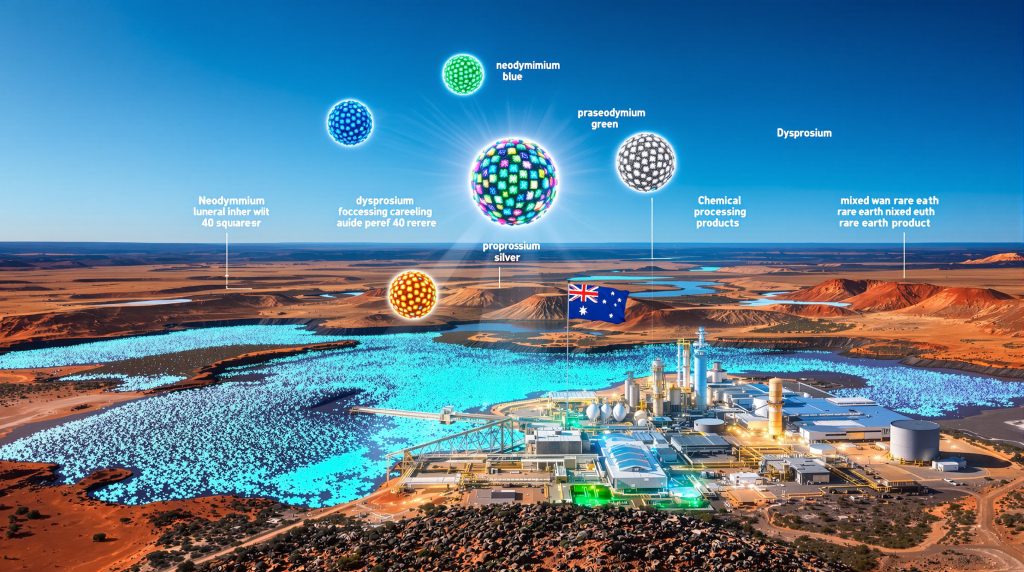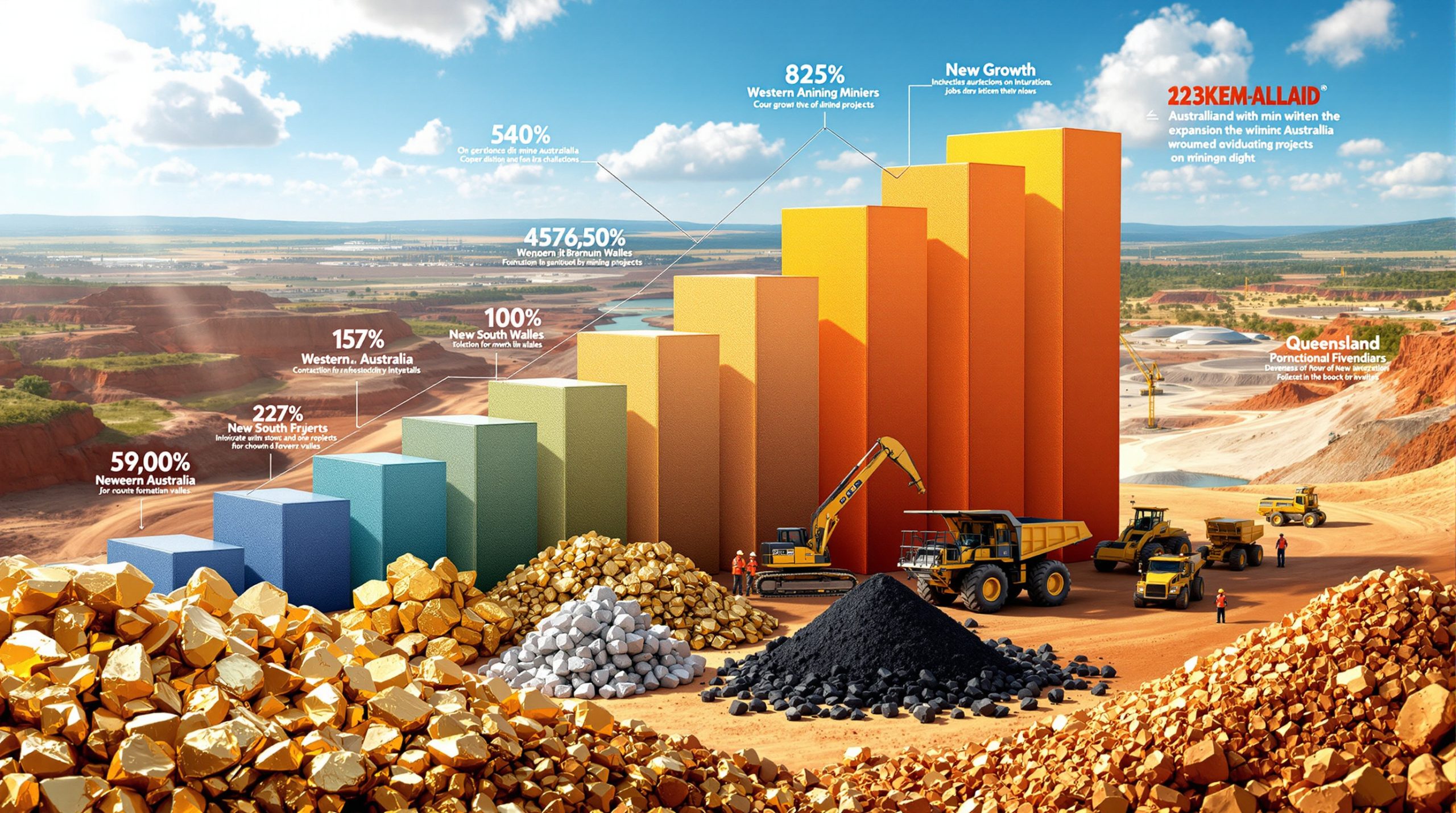Exploring Australia's Critical Rare Earth Project: Jupiter's Path to Production
Australia's mining landscape is witnessing a significant development with the Jupiter Project, the country's largest clay-hosted rare earth deposit. Positioned as a cornerstone asset in Western Australia's growing critical minerals energy transition, this project represents a strategic opportunity in the global rare earth supply chain at a time when these elements are increasingly vital for the clean energy transition.
Located in Western Australia's infrastructure-rich mining region, the Jupiter Project spans approximately 40 square kilometers of homogeneous rare earth mineralization. The Australian Government has recognized the strategic importance of such resources, investing AUD $2 billion in Australia's Critical Minerals Reserve as part of its Critical Minerals Strategy 2023-2030, positioning Australia to capitalize on its significant reserves as the world's second-largest rare earth resource holder.
What truly differentiates this deposit is its magnet rare earth element (MREE) dominant mineral basket, containing the critical elements needed for permanent magnets used in electric vehicles, wind turbines, and other clean energy technologies. With global rare earth production heavily concentrated in China (which controls approximately 70% of mining and 90% of processing capacity), projects like Jupiter represent Australia's opportunity to establish itself beyond its current 4% share of global production.
Key Project Characteristics
- Homogeneous clay-hosted deposit spanning 40 square kilometers
- Magnet rare earth element (MREE) dominant mineral basket
- Notably low uranium and thorium content compared to many competitors
- Proximity to existing transportation, power, and port infrastructure
- Strategic alignment with Australia's Critical Minerals Strategy
How Does the "Scale, Simplicity, Speed" Roadmap Work in Practice?
The development strategy for the Jupiter Project centers on three core principles that guide its advancement from resource to production. This trio of "Scale, Simplicity, and Speed" represents a practical approach to navigating the complexities of rare earth project development in a market hungry for non-Chinese supply alternatives.
Scale Advantages
The sheer size of the Jupiter deposit creates multiple operational benefits that support commercial viability:
- Consistent, homogeneous mineralization allowing for predictable processing
- Long potential mine life supporting substantial capital investment
- Resource scale sufficient to meet significant market demand
- Potential for phased expansion as market conditions evolve
The scale advantage translates directly to operational efficiency. With 40 square kilometers of relatively uniform mineralization, the project can support systematic mining plans with predictable feed grades and consistent processing performance over decades rather than years.
Simplicity in Design
The project's technical approach emphasizes straightforward solutions to complex challenges:
- Clay-hosted mineralization amenable to conventional mining methods
- Innovative beneficiation process achieving 95% mass rejection before leaching
- Grade upgrades of approximately 800% through physical separation
- Reduced chemical processing footprint compared to traditional approaches
- Simplified logistics due to low uranium and thorium content
This simplicity principle extends beyond just technical aspects to the entire development approach. The team describes their philosophy as "back to basics" engineering, avoiding the over-complication that has plagued many previous rare earth projects.
Speed to Market
The accelerated development timeline focuses on:
- Parallel workstreams across metallurgical testing and process optimization
- Strategic partnerships with established research organizations
- Milestone-driven funding approach to maintain momentum
- Targeting scoping study completion by mid-2025
- Streamlined regulatory pathway in Western Australia's established mining jurisdiction
Speed doesn't mean cutting corners, but rather efficient execution through parallel work programs. By simultaneously advancing metallurgical testing with multiple partners while progressing resource definition drilling, the project aims to move quickly through development milestones.
What Technical Challenges Must Be Overcome in Rare Earth Processing?
Rare earth processing presents unique metallurgical challenges that have historically limited development outside of China. The Jupiter Project's approach addresses several key technical hurdles through innovative processing methods.
Beneficiation Innovations
The project's most distinctive technical advantage comes from its mineral beneficiation insights:
- Physical separation techniques achieve 95% mass rejection before chemical processing
- Concentrate grades increased approximately 8x from resource grade
- Significantly reduced chemical reagent requirements
- Smaller leaching circuit footprint and associated capital costs
- Lower water and energy consumption in downstream processing
This beneficiation achievement is particularly significant as it addresses one of the most capital and operating cost-intensive aspects of rare earth production. By removing 95% of the mass before chemical processing begins, the approach potentially transforms the project economics.
Metallurgical Testing Program
The current metallurgical program involves multiple parallel workstreams:
| Testing Partner | Focus Area | Expected Outcomes |
|---|---|---|
| ANSTO | Leaching optimization | Mixed rare earth carbonate specifications |
| Munitech | Process flowsheet development | Integrated processing parameters |
| Gavaku | Closed-circuit pilot plant | Scale validation of beneficiation process |
These parallel testing programs ensure that as the project advances toward commercial design, all critical processing parameters are optimized simultaneously rather than sequentially.
Scale-Up Considerations
As the project advances toward commercial scale, several technical factors require attention:
- Variability testing across the deposit to ensure consistent processing performance
- Integration of beneficiation and hydrometallurgical circuits
- Optimization of reagent consumption and recovery
- Water management and recycling systems
- Waste management and environmental controls
Industry experience shows that the transition from laboratory success to commercial operation represents one of the greatest technical risks for rare earth projects. The Jupiter approach directly addresses this through systematic pilot testing focused on process integration.
How Does the Project Fit Within Global Rare Earth Supply Chains?
The rare earth market remains dominated by China, which controls approximately 70% of mining and 90% of processing capacity globally. However, structural shifts in the market create opportunities for new entrants focused on becoming preferred alternatives rather than attempting to displace Chinese production entirely.
Western Supply Chain Development
The Jupiter Project positions itself as a preferred non-Chinese alternative within emerging Western supply chains:
- Strategic alignment with Australia's Critical Minerals Strategy
- Potential supplier to Western separation facilities under development
- Beneficiary of various government incentive programs and grants
- Positioned to meet increasing demand for traceable, ESG-compliant rare earth sources
These emerging Western supply chains are being actively supported by government policies in the US, Europe, Japan and Australia, with floor pricing mechanisms established by institutions like the US Department of Defense to incentivize non-Chinese production.
Commercial Product Strategy
The initial commercial product will be a mixed rare earth carbonate (MREC):
- Intermediate product requiring further separation and processing
- Specifications being defined through current metallurgical programs
- Target product for potential offtake discussions with refiners
- Logistically advantaged due to low uranium and thorium content
This MREC approach represents a pragmatic first step in production, creating a saleable product while avoiding the immense capital requirements of fully integrated separation facilities.
Market Dynamics and Pricing
The rare earth market presents unique structural characteristics:
- Strategic rather than purely cyclical commodity dynamics
- Increasing price premiums for non-Chinese supply
- Floor pricing mechanisms emerging (e.g., US Department of Defense initiatives)
- Growing demand from electric vehicle and renewable energy sectors
Unlike many mining commodities that follow traditional supply-demand cycles, rare earths increasingly operate in a strategic market framework where security of supply and geopolitical considerations influence pricing and investment decisions.
What Timeline and Milestones Guide the Project's Development?
The development pathway follows a structured approach to de-risking and advancing the project, with clearly defined milestones tied to funding decisions.
Near-Term Objectives (6-12 Months)
- Completion of metallurgical test programs with ANSTO, Munitech, and Gavaku
- Production of first mixed rare earth carbonate samples
- Pilot plant operation to validate beneficiation at increased scale
- Resource definition drilling to upgrade classification
- Initiation of scoping study to establish preliminary economics
These near-term objectives focus primarily on technical validation of the processing approach and establishing baseline economic parameters.
Medium-Term Goals (12-18 Months)
- Completion of scoping study by mid-2025
- Establishment of preliminary project economics
- Advancement of environmental baseline studies
- Engagement with potential offtake partners
- Exploration of strategic partnerships and funding options
The medium-term objectives shift focus toward commercial development and establishing the framework for investment decisions.
Commercial Pathway
The project's commercial strategy focuses on:
- Producing mixed rare earth carbonate as an initial product
- Engaging with separation facilities for downstream processing
- Exploring strategic partnerships with OEMs and end-users
- Leveraging government initiatives supporting critical minerals
- Establishing the project as a cornerstone of Western rare earth supply
This disciplined stage-gated approach ensures that capital is allocated efficiently as the project progresses from technical validation to commercial development.
What Environmental and Social Considerations Impact Development?
Rare earth projects face particular scrutiny regarding environmental and social impacts. The Jupiter Project addresses these considerations through several approaches designed to minimize environmental footprint and maximize social benefits.
Environmental Advantages
The project benefits from several inherent characteristics that reduce environmental impact:
- Low uranium and thorium content simplifying waste management
- Mass rejection through beneficiation reducing chemical processing requirements
- Potential for reduced water and energy consumption
- Location in an established mining jurisdiction with clear regulatory frameworks
The low radioactive content is particularly significant, as many rare earth deposits contain uranium and thorium levels that create major waste management challenges and increase processing costs.
Regulatory Pathway
Western Australia provides a transparent and established regulatory environment:
- Clear permitting processes for mining and processing operations
- Established environmental assessment frameworks
- Strong governance structures supporting responsible development
- Alignment with Australia's ESG expectations for mining projects
Operating in this tier-one jurisdiction provides significant advantages for permitting timelines and investor confidence compared to many competing projects in less established mining regions.
Community Engagement
Sustainable development requires effective community engagement:
- Consultation with local stakeholders throughout the development process
- Potential employment and business opportunities for local communities
- Transparent communication about project impacts and benefits
- Commitment to responsible environmental management
This community focus reflects growing recognition that social license represents a critical success factor for resource development projects globally.
How Does the Project Compare to Other Australian Rare Earth Developments?
Australia has emerged as a focal point for rare earth development outside China, with several projects at various stages of advancement. While Australia currently accounts for approximately 4% of global rare earth production, its resource base positions it for significant growth.
Comparative Advantages
The Jupiter Project differentiates itself through several key characteristics:
- Scale: Largest clay-hosted rare earth resource in Australia
- Processing: Innovative beneficiation approach reducing processing complexity
- Location: Proximity to established infrastructure in Western Australia
- Composition: Magnet rare earth dominant basket with low radioactivity
These advantages create potential for both capital and operating cost advantages compared to competing projects that lack one or more of these characteristics.
Australian Rare Earth Landscape
The broader Australian rare earth sector includes:
- Operating mines producing concentrate for offshore processing
- Emerging projects across various geological settings
- Growing government support for critical minerals development
- Increasing investment in downstream processing capabilities
As Australia executes its Critical Minerals Strategy, the rare earth sector is receiving particular attention due to its strategic importance for clean energy technologies and defense applications.
What Lessons from Previous Mining Developments Apply to Jupiter?
Mining industry evolution requires applying lessons from previous experiences. Key principles being applied to the Jupiter Project include a systematic approach to de-risking and disciplined capital allocation.
Technical Approach
- "Back to basics" engineering philosophy avoiding over-complication
- Systematic de-risking before major capital commitments
- Strong focus on linking geology to metallurgy early in development
- Emphasis on proven technologies where possible
This pragmatic approach reflects hard-earned wisdom from previous mining developments where technical complexity led to cost overruns and schedule delays.
Commercial Strategy
- Disciplined capital allocation based on milestone achievement
- Clear stage-gating of development decisions
- Focus on potential for low capital and operating costs
- Transparent communication with stakeholders and markets
The milestone-driven approach ensures that each funding increment advances the project toward clear development goals rather than simply extending exploration activities.
Leadership Principles
- Building technical expertise through specialized team members
- Maintaining commercial focus throughout technical development
- Creating clear development pathways with defined objectives
- Balancing innovation with proven approaches
The leadership team includes technical experts with PhD qualifications working alongside experienced mining engineers, creating a balanced approach to both innovation and practical execution.
FAQ: Critical Questions About the Jupiter Rare Earth Project
What makes clay-hosted rare earth deposits different from other types?
Clay-hosted rare earth deposits differ significantly from hard-rock deposits in their mineralogy, extraction methods, and processing requirements. Unlike hard-rock deposits where rare earths are bound in complex minerals requiring energy-intensive crushing and grinding, clay deposits typically allow for simpler physical separation techniques initially.
The Jupiter deposit benefits from rare earth elements that are weakly bound to clay particles, enabling physical beneficiation before chemical processing. This characteristic allows for substantial mass rejection early in the process, reducing the volume of material requiring chemical treatment and potentially lowering both capital and operating costs compared to hard-rock operations.
How does the beneficiation process work to achieve 95% mass rejection?
The beneficiation process leverages the physical characteristics of the clay-hosted rare earth minerals to separate them from non-valuable material. While specific technical details remain proprietary, the process likely involves a combination of:
- Screening and classification to separate particle sizes
- Gravity separation techniques to exploit density differences
- Potentially magnetic separation to concentrate certain mineral fractions
- Specialized clay processing techniques adapted for rare earth minerals
This physical separation achieves approximately 95% rejection of non-valuable mass before chemical processing begins, dramatically reducing the size and cost of downstream processing facilities.
What are the key environmental considerations for rare earth processing?
Rare earth processing typically raises several environmental concerns that must be carefully managed:
-
Radioactivity: Many rare earth deposits contain uranium and thorium, requiring specialized waste management. The Jupiter deposit benefits from relatively low levels of these elements.
-
Chemical usage: Processing typically involves acids and other reagents that must be managed carefully. The beneficiation approach reduces the volume of material requiring chemical treatment.
-
Water management: Processing requires significant water, though recycling systems can reduce consumption. Western Australia's water scarcity makes efficient water management essential.
-
Land disturbance: Mining operations impact surface environments, requiring comprehensive mine reclamation advancements.
-
Energy consumption: Processing facilities require substantial energy, with implications for carbon emissions depending on energy sources.
How does the project address China's dominance in rare earth processing?
Rather than attempting to replace China's dominant position, the Jupiter Project aims to establish itself as a preferred non-Chinese alternative within Western supply chains. This approach includes:
- Producing a mixed rare earth carbonate suitable for processing in emerging Western separation facilities
- Focusing on magnet rare earths most critical to Western technology and defense applications
- Leveraging Australia's reputation for stable, transparent mining regulations
- Providing a traceable, ESG-compliant product meeting Western standards
- Potentially benefiting from government incentives designed to diversify supply chains
Further Exploration:
Readers interested in learning more about Australia's rare earth developments can also explore related educational content about critical minerals projects in Australia. The Australian government's Critical Minerals Strategy provides additional context on national priorities and support mechanisms for rare earth project development.
The rare earth sector continues to evolve rapidly, with new processing technologies, market mechanisms, and supply chain relationships developing as Western economies seek alternatives to China-dominated supply chains. As the Jupiter Project advances toward production, it represents an instructive case study in how Australia is positioning itself within this strategically important mineral sector.
Ready to Profit from the Next Major Mineral Discovery?
Discovery Alert's proprietary Discovery IQ model delivers instant notifications on significant ASX mineral discoveries, helping investors capitalise on opportunities like those in the rare earth sector. Explore our dedicated discoveries page to understand why historic mineral discoveries can generate substantial returns for early investors.




